Climate and Land Use/Land Cover Changes within the Sota Catchment (Benin, West Africa)
Abstract
:1. Introduction
2. Materials and Methods
2.1. Study Area
2.2. Datasets
2.2.1. Climate Station Data
2.2.2. Climate Data Quality Control
2.2.3. Gridded Data
2.2.4. Satellite Images
2.3. Climate and Land Cover Data Analyses
2.3.1. Standardized Rainfall Anomaly Index
2.3.2. Mean Annual Rainfall Catchment Calculation and Break Points Detection
2.3.3. Trend Analysis of Rainfall and Temperature
2.3.4. Land Cover Classification and Assessment of the Changes
3. Results
3.1. Satellite Rainfall Data Validation
3.2. Rainfall Statistical Characteristics
3.3. Spatial Distribution of Rainfall in the Sota Catchment from 1960–2019
3.4. Rainfall Anomalies Analysis
3.5. Rainfall Break Points Detection
- -
- A wet period from 1960 to 1972 (with an average annual rainfall of 1127.85 mm),
- -
- A dry period from 1973–1987 (with an average annual rainfall of 967.24 mm)
- -
- A wet period from 1988–2019 (with an average annual rainfall of 1072.37 mm).
3.6. Rainfall Trend Analysis
3.7. Temperature Trend Analysis
3.8. Temperature Break Points Analysis
3.9. Land Cover Change Detection over the Sota Catchment
4. Discussion
4.1. Climate Assessment of the Sota Catchment
4.2. Land Cover Assessment of the Sota Catchment
4.3. Relationship between Climate and Land Use Changes in the Sota Catchment
4.4. Implications of Climate and Land Cover Changes
5. Conclusions
Author Contributions
Funding
Data Availability Statement
Conflicts of Interest
References
- Aduah, M. Impacts of Global Changes on a Lowland Rainforest Region of West Africa. Doctoral Dissertation, University of KwaZulu-Natal, Durban, South Africa, 2016. [Google Scholar]
- IPCC. Climate Change 2014: Synthesis Report; Pachauri, R.K., Meyer, L.A., Eds.; IPCC: Geneva, Switzerland, 2015; Volume 151. [Google Scholar]
- Guo, J.; Kubli, D.; Saner, P. The Economics of Climate Change: No Action Not an Option. Swiss Re Institute. April 2021, p. 34. Available online: https://www.swissre.com/institute/research/topics-and-risk-dialogues/climate-and-natural-catastrophe-risk/expertise-publication-economics-of-climate-change.html (accessed on 5 October 2023).
- Benti, F. Spatiotemporal Attribution and Trends of Climate Variables in Iluababora Zone, Oromia National Regional State, Ethiopia. J. Sci. Sustain. Dev. 2019, 7, 52–64. [Google Scholar]
- Winkler, K.; Fuchs, R.; Rounsevell, M.; Herold, M. Global land use changes are four times greater than previously estimated. Nat. Commun. 2021, 12, 2501. [Google Scholar] [CrossRef]
- Pielke, R.A., Sr.; Pitman, A.; Niyogi, D.; Mahmood, R.; McAlpine, C.; Hossain, F.; Goldewijk, K.K.; Nair, U.; Betts, R.; Fall, S.; et al. Land use/land cover changes and climate: Modeling analysis and observational evidence. Wiley Interdiscip. Rev. Clim. Chang. 2011, 2, 828–850. [Google Scholar] [CrossRef]
- IPCC. Climate Change and Land. In An IPCC Special Report on Climate Change, Desertification, Land Degradation, Sustainable Land Management, Food Security, and Greenhouse Gas Fluxes in Terrestrial Ecosystems; IPCC: Geneva, Switzerland, 2019. [Google Scholar]
- Tong, S.T.Y.; Sun, Y.; Ranatunga, T.; He, J.; Yang, Y.J. Predicting plausible impacts of sets of climate and land use change scenarios on water resources. Appl. Geogr. 2012, 32, 477–489. [Google Scholar] [CrossRef]
- Bryan, E.; Ringler, C.; Okoba, B.; Roncoli, C.; Silvestri, S.; Herrero, M. Adapting agriculture to climate change in Kenya: Household strategies and determinants. J. Environ. Manag. 2013, 114, 26–35. [Google Scholar] [CrossRef]
- Fink, A.H.; Christoph, M.; Ermert, V.; Kuhn, A.; Heckelei, T.; Diekkrüger, B. Impacts of global change in South of the Sahara; Springer: Berlin/Heidelberg, Germany, 2010; pp. 16–23. [Google Scholar]
- Lawin, A.E. Analyse Climatologique et Statistique du Régime Pluviométrique de la Haute Vallée de l’Ouémé à Partir des Données Pluviographiques AMMACATCH Bénin. Ph.D. Thesis, Grenoble INPG (France) and Université d’Abomey-Calavi, Abomey-Calavi, Benin, 2007. [Google Scholar]
- Nicholson, S.E.; Grist, J.P. A conceptual model for understanding rainfall variability in the West African Sahel on interannual and interdecadal timescales. Int. J. Climatol. 2001, 21, 1733–1757. [Google Scholar] [CrossRef]
- Adejuwon, J.O.; Balogun, E.E.; Adejuwon, S.A. On the annual and seasonal patterns of rainfall fluctuations in sub-Saharan West Africa. Int. J. Climatol. 1990, 10, 839–848. [Google Scholar] [CrossRef]
- Hulme, M. African climate change: 1900–2100. Clim. Res. 2001, 17, 145–168. [Google Scholar] [CrossRef]
- Food and Agriculture Organization (FAO). Global Forest Resources Assessment 2010: Main Report; Food and Agriculture Organization of the United Nations: Rome, Italy, 2010; p. 378. [Google Scholar]
- Vissin, E. Impact de la Variabilité Climatique et de la Dynamique des États de Surface sur les Écoulements du Bassin Béninois du Fleuve Niger. Doctoral Dissertation, Université de Bourgogne, Bourgogne, France, 2007. [Google Scholar]
- CeRPA Borgou-Alibori. Centre Régional pour la Promotion Agricole de Parakou. Evolution des Statistiques de Production Cotonnière sur les 24 Dernières Campagnes Agricoles (1989–1990 à 2012–2013); CeRPA: Parakou, Bénin, 2014. [Google Scholar]
- Oyerinde, G.T.; Olowookere, B.T. Observed shift and merge of hydrological regimes in the sota catchment, Benin; an evidence of climate. Int. J. Res. Granthaalayah 2018, 6, 205–211. [Google Scholar] [CrossRef]
- Zakari, S.; Tente, B.A.H.; Imorou, I.T.; Yabi, I.; Afouda, F.; N’Bessa, B. Variabilité hydropluviométrique et dynamique de l’occupation des terres dans le bassin de la Sota à l’exutoire de Coubéri au Bénin (Afrique de l’Ouest). Int. J. Innov. Appl. Stud. 2015, 13, 235–250. [Google Scholar]
- Koumassi, D.H. Risques Hydroclimatiques et Vulnerabilites des Ecosystemes dans le Bassin Versant de la Sota a L’exutoire de Couberi. Doctoral Dissertation, Université d’Abomey Calavi, Abomey-Calavi, Benin, 2014. Available online: https://hal.archives-ouvertes.fr/tel-01572602 (accessed on 6 June 2023).
- Badou, D.F.; Kapangaziwiri, E.; Diekkrüger, B.; Afouda, A. Evaluation of recent hydro-climatic changes in four tributaries of the Niger River basin (West Africa). Hydrol. Sci. J. 2016, 62, 715–728. [Google Scholar] [CrossRef]
- Sambieni, K.S.; Hountondji, F.C.C.; Sintondji, L.O.; Fohrer, N. Spatial distribution of water reservoirs in the Sota catchment (Benin, West Africa) and implications for local development. Heliyon 2023, 9, e14458. [Google Scholar] [CrossRef]
- Ahokpossi, Y. Analysis of the rainfall variability and change in the Republic of Benin (West Africa). Hydrol. Sci. J. 2018, 63, 2097–2123. [Google Scholar] [CrossRef]
- Paul, A.; Bhowmik, R.; Chowdary, V.; Dutta, D.; Sreedhar, U.; Sankar, H. Trend analysis of time series rainfall data using robust statistics. J. Water Clim. Chang. 2017, 8, 691–700. [Google Scholar] [CrossRef]
- Yu, P.S.; Yang, T.C.; Wu, C.K. Impact of climate change on water resources in southern Taiwan. J. Hydrol. 2002, 260, 161–175. [Google Scholar] [CrossRef]
- Wabi, M.A.; Lucas, R.; Kakaï, G. Characterization of Spatio-temporal Trends in Long- term Rainfall of Three Weather Stations in Benin: Implications for Agricultural Decision Making. Res. Sq. 2021, 1–21. [Google Scholar] [CrossRef]
- Akinsanola, A.A.; Ogunjobi, K.O. Recent homogeneity analysis and long-term spatio-temporal rainfall trends in Nigeria. Theor. Appl. Climatol. 2017, 128, 275–289. [Google Scholar] [CrossRef]
- Costa, R.L.; Barros Gomes, H.; Cavalcante Pinto, D.D.; da Rocha Júnior, R.L.; dos Santos Silva, F.D.; Barros Gomes, H.; Lemos da Silva, M.C.; Luís Herdies, D. Gap Filling and Quality Control Applied to Meteorological Variables Measured in the Northeast Region of Brazil. Atmosphere 2021, 12, 1278. [Google Scholar] [CrossRef]
- Bodjrenou, R.; Cohard, J.M.; Hector, B.; Lawin, E.A.; Chagnaud, G.; Danso, D.K.; N’tcha M’po, Y.; Badou, F.; Ahamide, B. Evaluation of Reanalysis Estimates of Precipitation, Radiation, and Temperature over Benin (West Africa). J. Appl. Meteorol. Climatol. 2023, 62, 1005–1022. [Google Scholar] [CrossRef]
- Cucchi, M.; Weedon, G.P.; Amici, A.; Bellouin, N.; Lange, S.; Müller Schmied, H.; Hersbach, H.; Buontempo, C. WFDE5: Bias-adjusted ERA5 reanalysis data for impact studies. Earth Syst. Sci. Data 2020, 12, 2097–2120. [Google Scholar] [CrossRef]
- Hersbach, H.; Bell, B.; Berrisford, P.; Hirahara, S.; Horányi, A.; Muñoz-Sabater, J.; Nicolas, J.; Peubey, C.; Radu, R.; Schepers, D.; et al. The ERA5 global reanalysis. Q. J. R. Meteorol. Soc. 2020, 146, 1999–2049. [Google Scholar] [CrossRef]
- Muñoz-Sabater, J. ERA5-Land Hourly Data from 1981 to Present. Copernicus Climate Change Service Climate Data Store. 2019. Available online: https://cds.climate.copernicus.eu/cdsapp#!/dataset/10.24381/cds.e2161bac?tab=overview (accessed on 25 January 2021).
- Ali, A.; Lebel, T. The Sahelian standardized rainfall index revisited. Int. J. Climatol. 2009, 29, 1705–1714. [Google Scholar] [CrossRef]
- Mckee, T.B.; Doesken, N.J.; Kleist, J. The Relationship of Drought Frequency and Duration to Time Scales. In Proceedings of the 8th Conference on Applied Climatology, Anaheim, CA, USA, 17–22 January 1993; pp. 179–184. [Google Scholar]
- Thiessen, A.H. Precipitation Averages for Large Areas. Mon. Weather. Rev. 1911, 39, 1082–1084. [Google Scholar] [CrossRef]
- Pettitt, A.N. A non-parametric approach to the change-point problem. Appl. Statist. 1979, 28, 126–135. [Google Scholar] [CrossRef]
- James, N.A.; Kejariwal, A.; Matteson, D.S. Leveraging cloud data to mitigate user experience from ‘breaking bad’. In Proceedings of the 2016 IEEE International Conference on Big Data (Big Data), Washington, DC, USA, 5–8 December 2016; pp. 3499–3508. [Google Scholar] [CrossRef]
- Mann, H.B. Non-parametric tests against trend. Econometrica 1945, 33, 245–259. [Google Scholar] [CrossRef]
- Kendall, M. Multivariate Analysis; Charles Griffin & Company: London, UK, 1975; p. 309. [Google Scholar]
- Hirsch, R.M.; Slack, J.R. A nonparametric trend test for seasonal data with serial dependence. Water Resour. Res. 1984, 20, 727–732. [Google Scholar] [CrossRef]
- Sen, P.K. Estimates of the Regression Coefficient Based on Kendall’s Tau. J. Am. Stat. Assoc. 1968, 63, 1379–1389. [Google Scholar] [CrossRef]
- Dossa, L.O.S.N.; Dassou, G.H.; Adomou, A.C.; Ahononga, F.C.; Biaou, S. Dynamique spatio-temporelle et vulnérabilité des unités d’occupation du sol de la Forêt Classée de Pénéssoulou de 1995 à 2015 (Bénin, Afrique de l’Ouest). Sci. De La Vie De La Terre Et Agron. 2021, 9, 2. [Google Scholar]
- Ahononga, F.C.; Gouwakinnou, N.G.; Biaou, S. Vulnérabilité des terres des écosystèmes du domaine soudanien au Bénin de 1995 à 2015. Bois. Et Forêts. Des. Trop. 2020, 346, 35–50. [Google Scholar] [CrossRef]
- Biaou, S.; Houeto, F.; Gouwakinnou, G.; Biaou, S.S.H.; Awessou, B.; Tovihessi, S.; Tete, R. Dynamique spatio-temporelle de l’occupation du sol de la forêt classée de Ouénou-Bénou au Nord Bénin. Des Images Satellites Pour La Gestion Durable Des Territoires En Afrique. 2019, p. 22. Available online: https://hal.archives-ouvertes.fr/hal-02189367 (accessed on 12 November 2023).
- Kantakumar, L.N.; Neelamsetti, P. Multi-temporal land use classification using hybrid approach. Egypt. J. Remote Sens. Sp. Sci. 2015, 18, 289–295. [Google Scholar] [CrossRef]
- Jensen, J.R. Introductory Digital Image Processing: A Remote Sensing Perspective; Prentice Hall: Hoboken, NJ, USA, 1996. [Google Scholar]
- Houssoukpèvi, I.A.; Le Maire, G.; Aholoukpè, H.N.S.; Fassinou, D.J.M.; Amadji, G.L.; Chapuis-Lardy, L.; Chevallier, T. Effect of land use change on carbon stocks in an agricultural region of southern Benin. Land Degrad. Dev. 2023, 34, 1447–1463. [Google Scholar] [CrossRef]
- Bah, O.A.; One, T.; Yaffa, S.; Ndiaye, M.L. Land Use and Land Cover Dynamics in Central River Region of the Gambia, West Africa from 1984 to 2017. Am. J. Mod. Energy 2019, 5, 5. [Google Scholar] [CrossRef]
- Liu, C.; Frazier, P.; Kumar, L. Comparative assessment of the measures of thematic classification accuracy. Remote Sens. Environ. 2007, 107, 606–616. [Google Scholar] [CrossRef]
- Olofsson, P.; Foody, G.M.; Stehman, S.V.; Woodcock, C.E. Making better use of accuracy data in land change studies: Estimating accuracy and area and quantifying uncertainty using stratified estimation. Remote Sens. Environ. 2013, 129, 122–131. [Google Scholar] [CrossRef]
- Hare, W. Assessment of Knowledge on Impacts of Climate Change: Contribution to the Specification of Art, 2 of the UNFCCC; WBGU: Postdam, Germany; Berlin, Germany, 2003. [Google Scholar]
- Cherkos, A. The Rainfall Variability of an Area with Coefficient of Variation; CSA 2006/7 National Statistics; Central Statistical Agency: Addis Ababa, Ethiopia, 2001.
- CILSS. Landscapes of West Africa—A Window on a Changing World; U.S. Geological Survey EROS: Garretson, SD, USA, 2016.
- Mansourmoghaddam, M.; Rousta, I.; Zamani, M.; Haraldur, O. Investigating and predicting Land Surface Temperature (LST) based on remotely sensed data during 1987–2030 (A case study of Reykjavik city, Iceland). Urban Ecosyst. 2023, 26, 337–359. [Google Scholar] [CrossRef]
- World Bank. Report on the Forests in Benin; The World Bank Group: Washington, DC, USA, 2020. [Google Scholar]
- Zakari, S.; Mazo, I.; Toko Imorou, I.; Djaouga, M.; Arouna, O.; Thomas, O. Cartographie des changements spatio-temporels des unités d’occupation des terres dans la forêt classée de Goungoun et ses terroirs riverains, In Actes de la Conférence; OSFACO: Cotonou, Benin, 2018; pp. 229–246. [Google Scholar]
- World Research Institute. Global Emissions and Local Deforestation Are Combining to Create Dangerous Levels of Heat Stress in the Tropics; Report; World Research Institute: Washington, DC, USA, 2023. [Google Scholar]
- IPCC. Summary for Policymakers of IPCC Special Report on Global Warming of 1.5 °C Approved by Governments; IPCC: Geneva, Switzerland, 2018. [Google Scholar]
- Hatfield, J.L.; Prueger, J.H. Temperature extremes: Effect on plant growth and development. Weather Clim. Extrem. 2015, 10, 4–10. [Google Scholar] [CrossRef]
- Ahmed, K.F.; Wang, G.; Yu, M.; Koo, J.; You, L. Potential impact of climate change on cereal crop yield in West Africa. Clim. Chang. 2015, 133, 321–334. [Google Scholar] [CrossRef]
- Gitz, V.; Meybeck, A.; Lipper, L.; Young, C.; Braatz, S. Climate Change and Food Security: Risks and Responses; Food and Agriculture Organization of the United Nations (FAO) Report; FAO: Rome, Italy, 2016. [Google Scholar]
- Ayeni, A.; Kapangaziwiri, E.; Soneye, A.; Engelbrecht, F. Assessing the impact of global changes on the surface water resources of southwestern Nigeria. Hydrol. Sci. J. 2015, 60, 1956–1971. [Google Scholar] [CrossRef]
- Kashaigili, J.; Majaliwa, A. Implications of land use and land cover changes on hydrological regimes of the Malagarasi River, Tanzania. J. Agric. Sci. Appl. 2013, 2, 45–50. [Google Scholar] [CrossRef]
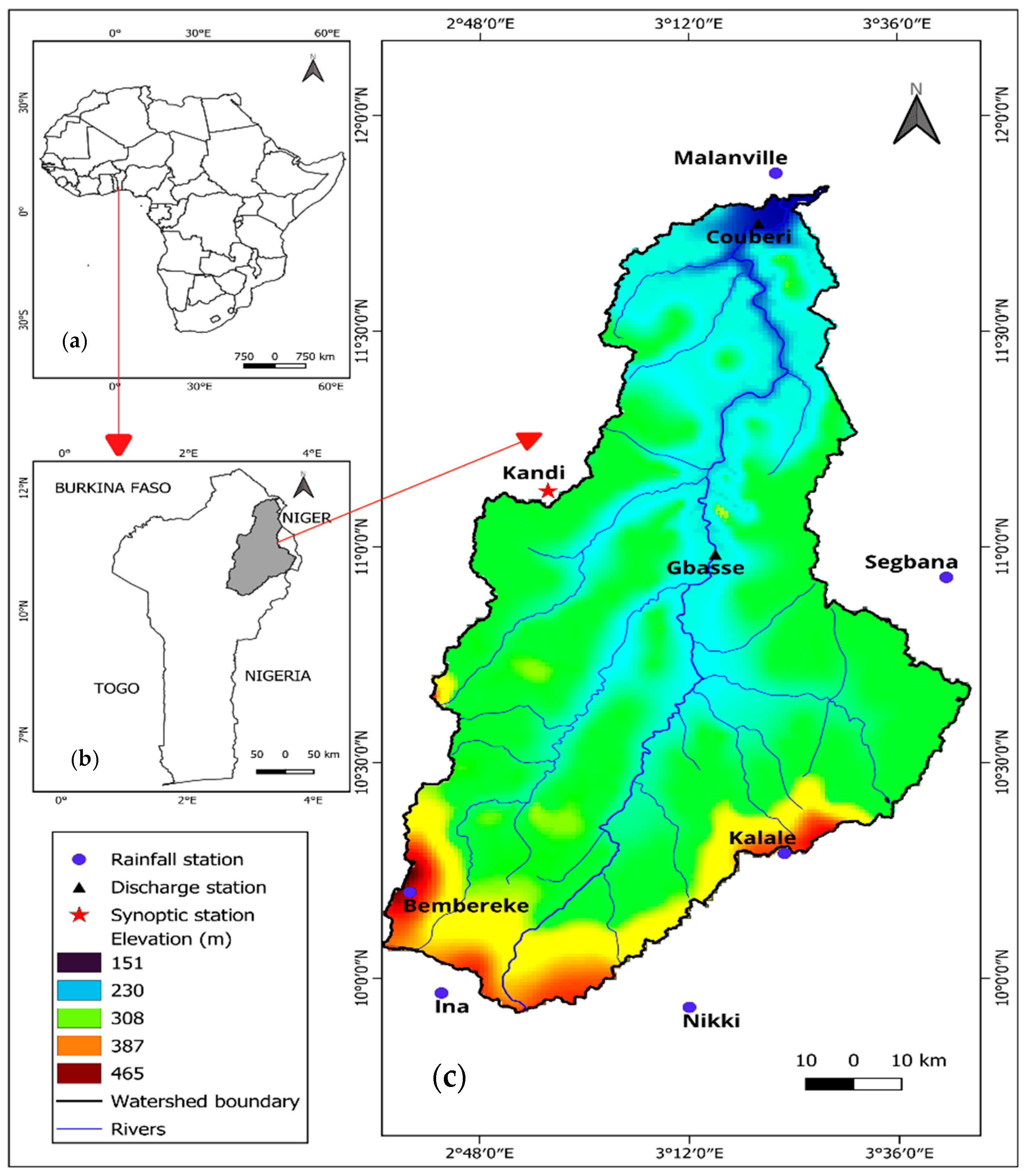
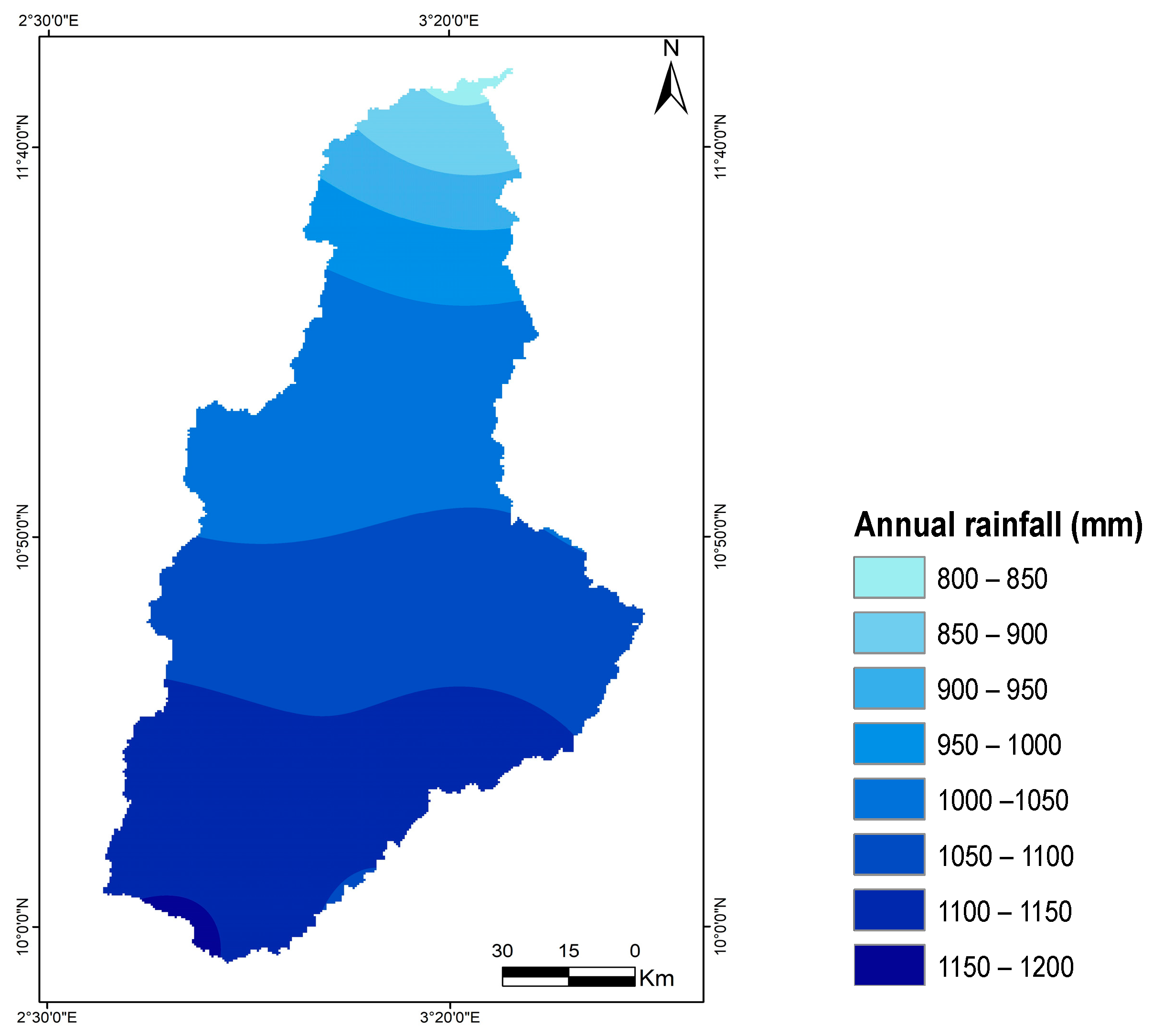
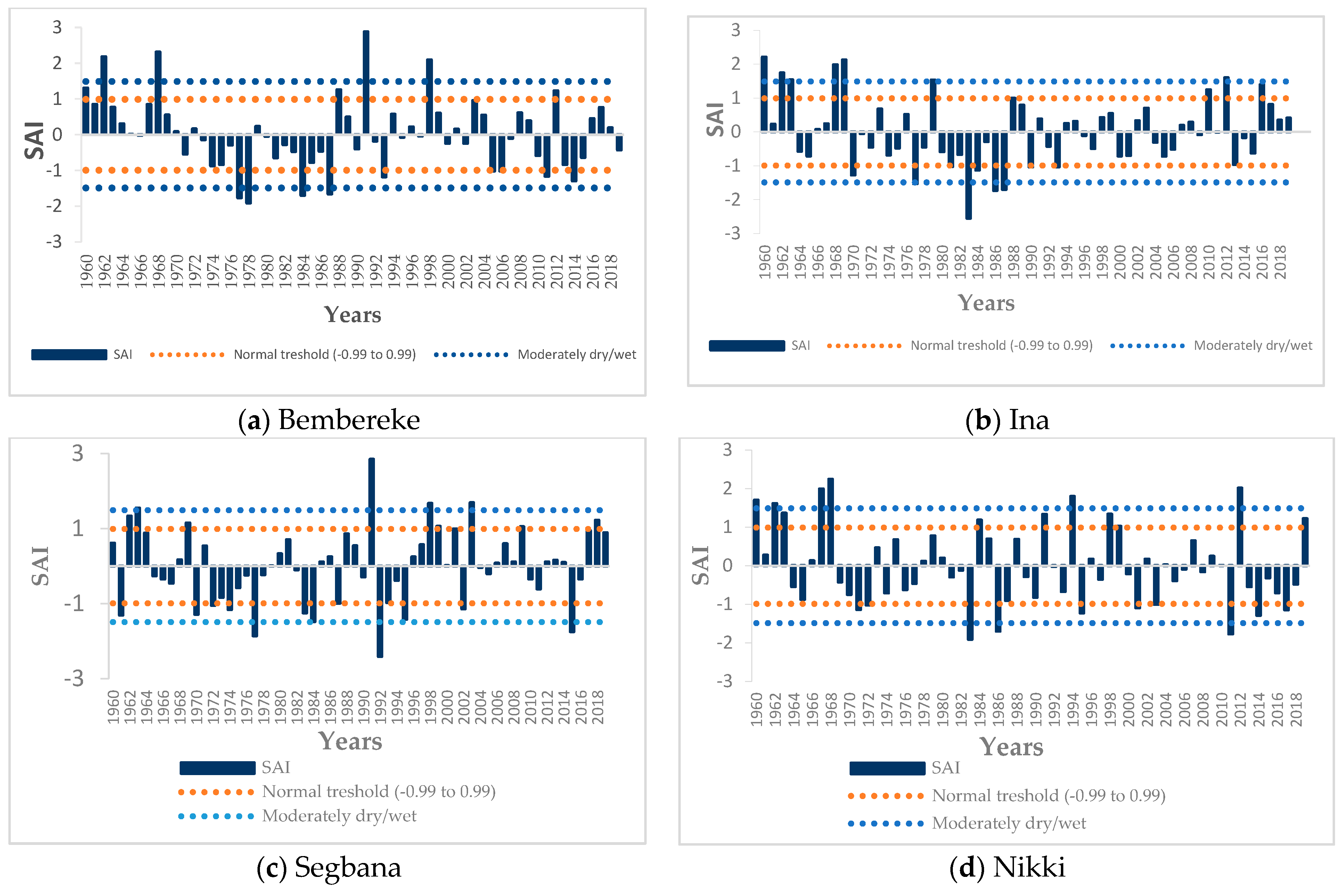
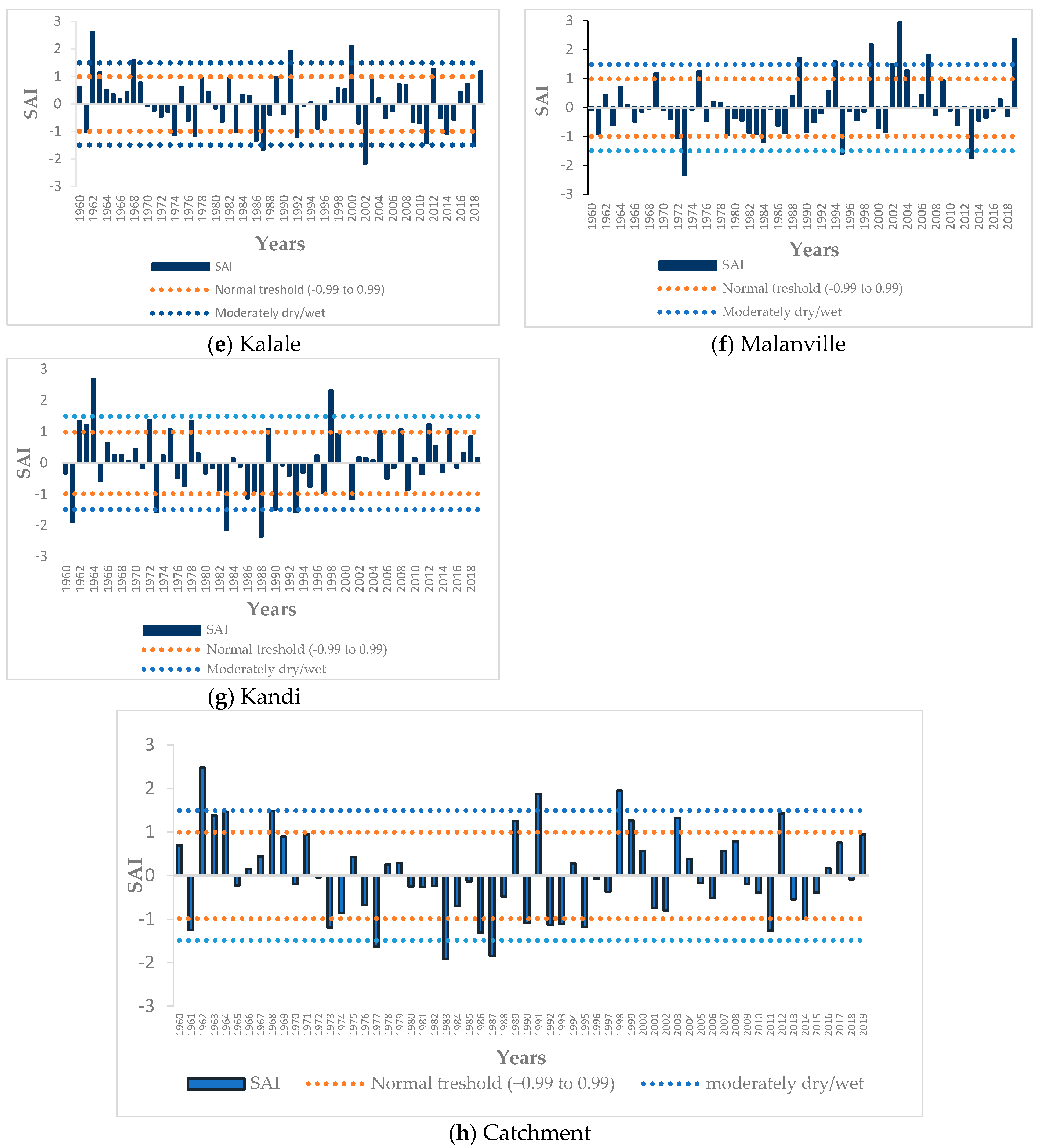
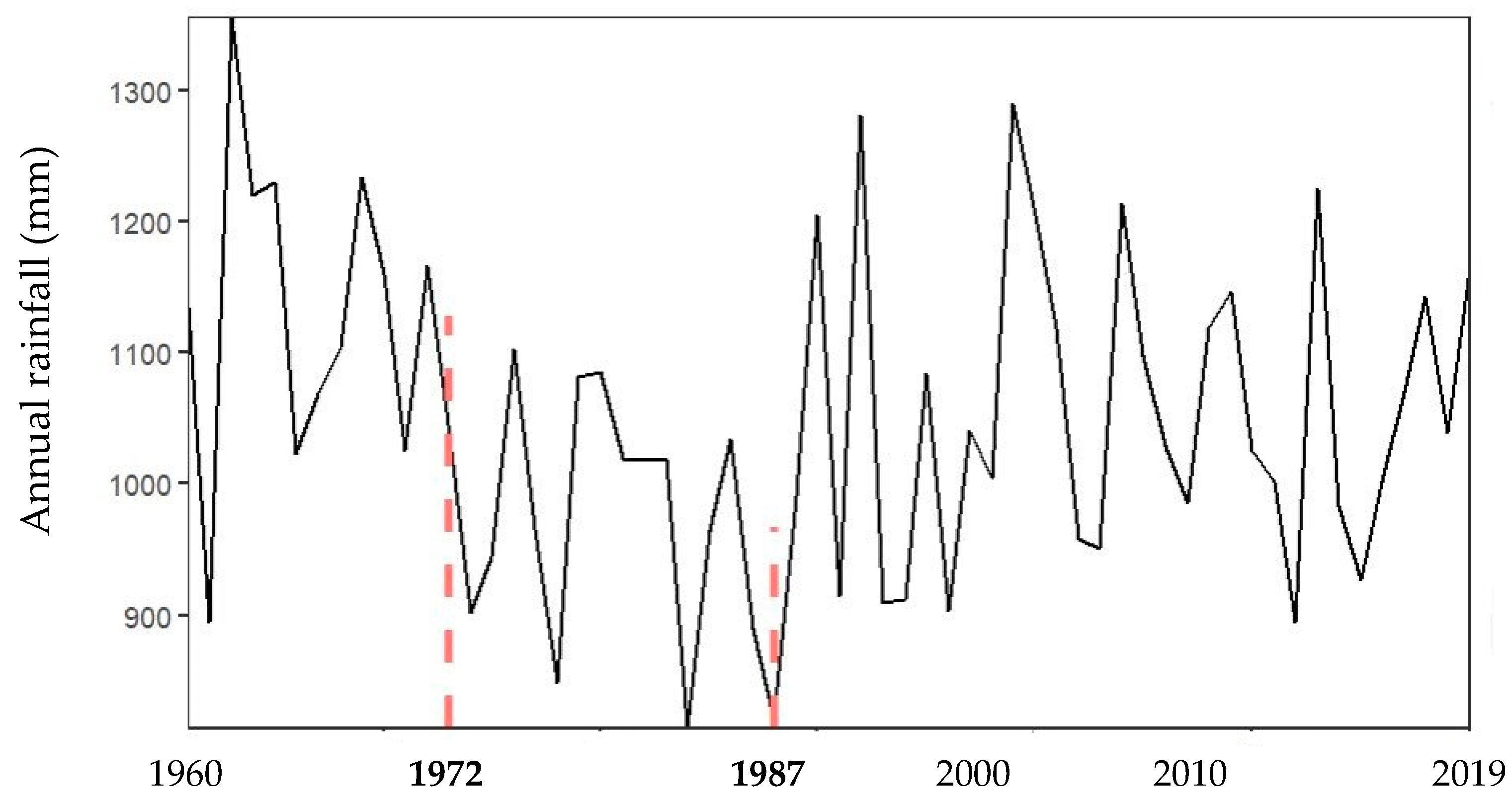
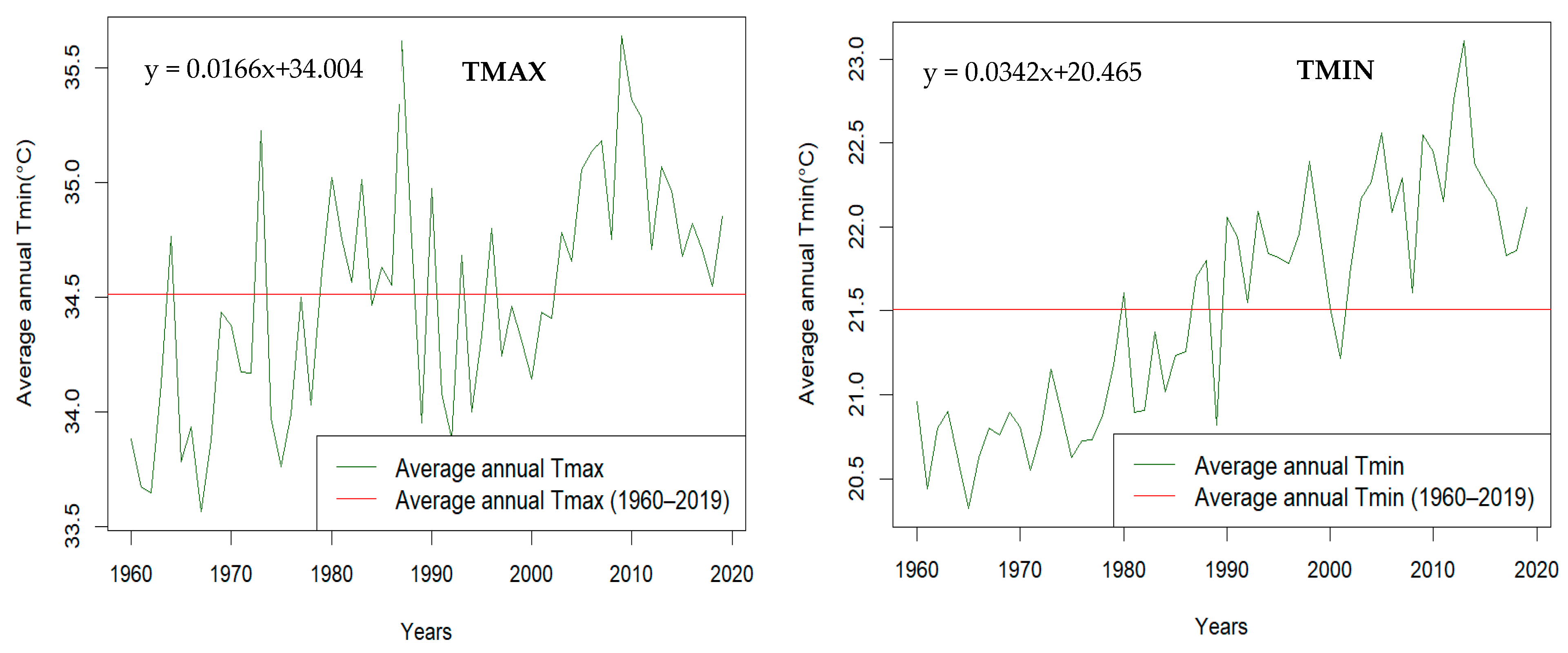


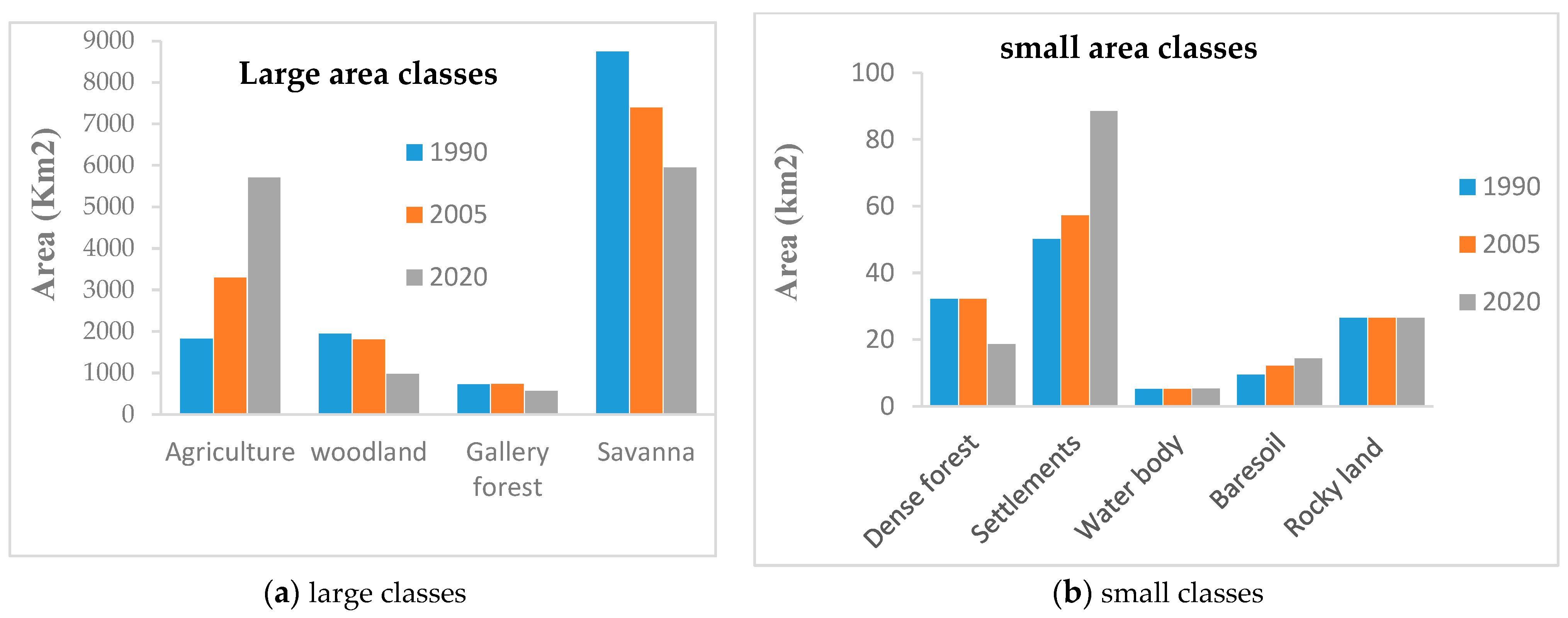
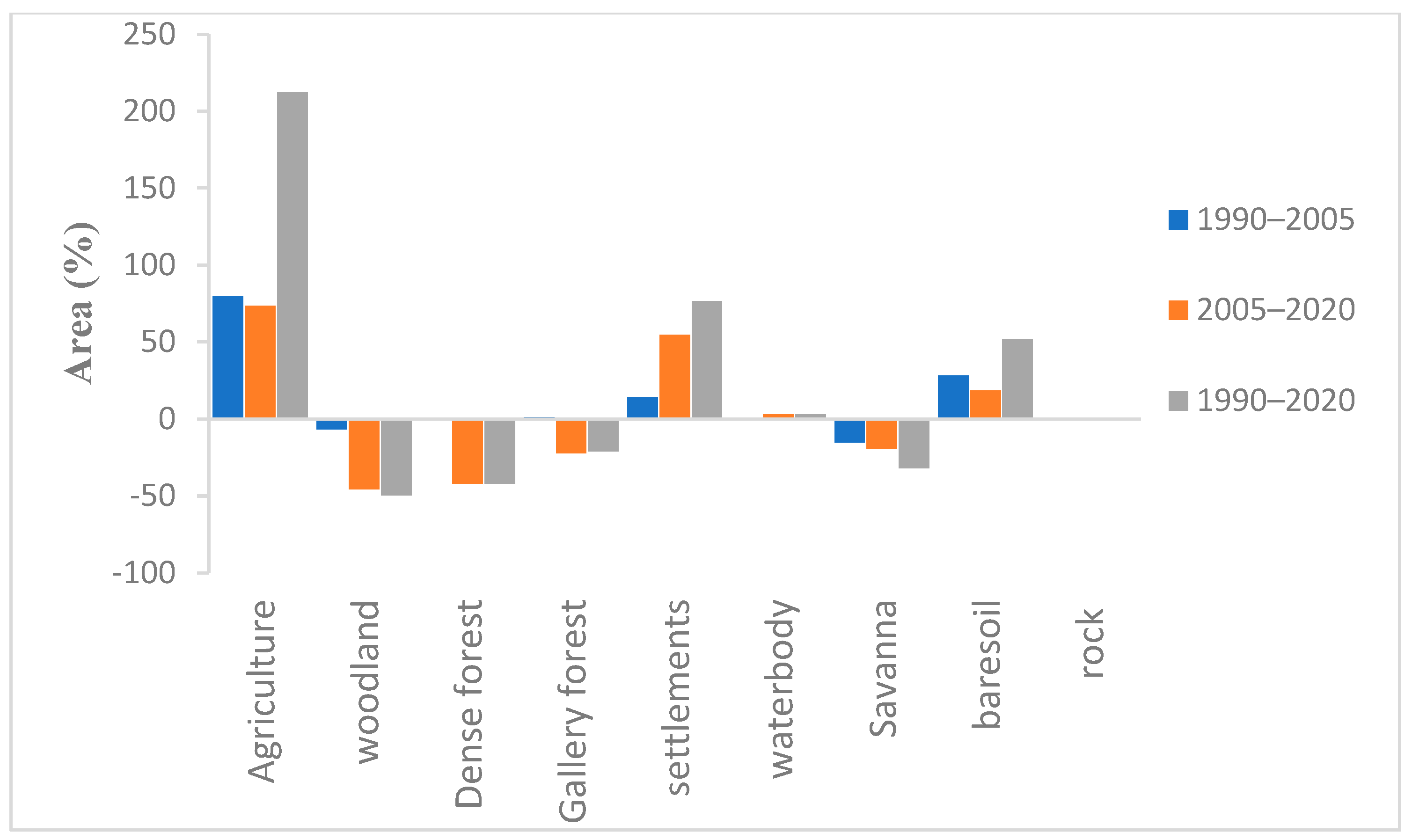
| Stations | Longitude | Latitude | Number of Years with Missing Data | % of Missing Data | Number of Years Considered after Quality Control |
|---|---|---|---|---|---|
| Kandi (synoptic station) | 2.93 | 11.13 | 0 | 0 | 60 |
| Malanville | 3.4 | 11.87 | 21 | 6.51 | 53 |
| Segbana | 3.7 | 10.93 | 32 | 33.69 | 35 |
| Kalale | 3.38 | 10.3 | 10 | 1.96 | 56 |
| Bembereke | 2.67 | 10.2 | 7 | 1.26 | 58 |
| Nikki | 3.2 | 9.93 | 23 | 13.15 | 47 |
| Ina | 2.73 | 9.97 | 22 | 13.57 | 49 |
| Indices | Mathematical Expressions | Description | Perfect Score |
|---|---|---|---|
| Pearson Correlation | Rg is gauge rainfall observation; Rs is satellite rainfall estimate is average gauge rainfall observation is average satellite rainfall estimate The values range from −1 to 1. | 1 | |
| Root mean Square | The number of data pairs is n; the value ranges from 0 to ∞. The lower the RMSE, the better a given model is able to “fit” a dataset. | 0 | |
| Percent bias (%) | ≤±15% is very good | 0 |
| SAI Value | Category |
|---|---|
| ≥2.00 | Extremely wet |
| 1.5 to 1.99 | Severely wet |
| 1.0 to 1.49 | Moderately wet |
| −0.99 to 0.99 | Near normal |
| −1.00 to −1.49 | Moderately dry |
| −1.50 to −1.99 | Severely dry |
| ≤2.00 | Extremely dry |
| Locations | R | PBIAS | RMSE | |||
|---|---|---|---|---|---|---|
| ERA5 | WFDE5 | ERA5 | WFDE5 | ERA5 | WFDE5 | |
| Kandi | 0.18 | 0.38 | −19.99 | 10.11 | 266.33 | 178.39 |
| Malanville | 0.13 | 0.53 | −23.32 | 34.59 | 240.43 | 300.47 |
| Segbana | 0.15 | 0.39 | −13.54 | 6.58 | 242.41 | 179.52 |
| Kalale | 0.28 | 0.33 | −2.65 | −0.83 | 222.87 | 201.35 |
| Bembereke | 0.42 | 0.64 | −4.99 | −2.46 | 189.78 | 150.28 |
| Nikki | 0.68 | 0.48 | 5.68 | 1.85 | 143.30 | 156.97 |
| Ina | 0.51 | 0.68 | −3.56 | −5.46 | 168.74 | 149.89 |
| Stations | Mean | Standard Deviation | Max | Min | Coefficient of Variation | Skewness | Kurtosis |
|---|---|---|---|---|---|---|---|
| Kandi | 1019.24 | 155.12 | 1436.2 | 655.1 | 15.22 | 0.06 | 0.44 |
| Malanville | 838.83 | 157.76 | 1301.48 | 472.2 | 18.81 | 0.75 | 0.93 |
| Segbana | 1046.21 | 166.63 | 1479.7 | 679 | 14.56 | 0.06 | 0.22 |
| Kalale | 1119.87 | 202.41 | 1661.6 | 666.3 | 18.07 | 0.24 | −0.02 |
| Bembereke | 1115.99 | 200.58 | 1695.9 | 725 | 17.97 | 0.54 | 0.71 |
| Nikki | 1082.89 | 168.17 | 1459.5 | 761.9 | 15.53 | 0.41 | −0.44 |
| Ina | 1171.73 | 188.0 | 1585.7 | 693.2 | 16.04 | 0.19 | 0.02 |
| Locations | Normal Years (%) | Wet Years (%) | Dry Years (%) |
|---|---|---|---|
| Bembereke | 73.33 | 11.67 | 15 |
| Ina | 70 | 15 | 15 |
| Segbana | 66.67 | 15 | 18.33 |
| Nikki | 63.33 | 20 | 16.67 |
| Kalale | 68.33 | 18.33 | 13.34 |
| Malanville | 75 | 16.67 | 8.33 |
| Kandi | 66.67 | 20 | 13.33 |
| catchment | 63.33 | 16.67 | 20 |
| Periods | Break Points | Mean (mm) | Difference (mm) | Student t-Test |
|---|---|---|---|---|
| 1960–1972 | 1972 | 1127.85 | −160.60 | p value = 0.000 *** |
| 1973–1987 | 967.24 | |||
| 1973–1987 | 1987 | 967.24 | 105.13 | p value = 0.03 ** |
| 1988–2019 | 1072.37 |
| Stations | Annual Rainfall | Pre-Monsoon | Monsoon | ||||||
|---|---|---|---|---|---|---|---|---|---|
| Z | p Value | Sen | Z | p Value | Sen | Z | p Value | Sen | |
| Bembereke | −0.95 | 0.06 | −1.65 | −5.67 | 0.000 *** | −0.88 | −2.05 | 0.04 | −1.71 |
| Nikki | −3.74 | 0.0001 *** | −1.64 | −1.24 | 0.21 | −0.39 | −3.66 | 0.000 *** | −2.64 |
| Kalale | −3.35 | 0.0007 *** | −1.99 | −2.91 | 0.003 ** | −0.64 | −2.58 | 0.009 ** | −1.31 |
| Ina | −3.74 | 0.0002 *** | −1.64 | −0.11 | 0.91 | −0.03 | 0.19 | 0.84 | 0.15 |
| Segbana | 2.66 | 0.008 ** | 1.22 | −2.99 | 0.002 ** | −0.55 | 1.17 | 0.24 | 0.55 |
| Malanville | 0.28 | 0.78 | 0.26 | 6.38 | 0.000 *** | 0.99 | 1.92 | 0.05 | 1.07 |
| Kandi | 0.27 | 0.78 | 0.07 | 3.24 | 0.001 ** | 0.5 | −0.35 | 0.73 | −0.31 |
| catchment | −0.83 | 0.40 | −0.49 | ||||||
| Periods | Modified Mann Kendall | Statistical Characteristics | ||||
|---|---|---|---|---|---|---|
| z | p Value | Sen | Average Annual Rainfall (mm) | Max (mm) | Min (mm) | |
| 1960–1989 | −6.89 | 0.000 *** | −8.75 | 1045.52 | 1355.43 | 813.29 |
| 1990–2019 | 1.53 | 0.12 | 2.11 | 1054.76 | 1289.95 | 894 |
| Modified Mann Kendall (MMK) | ||||||
|---|---|---|---|---|---|---|
| Periods | Tmax | Tmin | ||||
| Z | p Value | Sen | Z | p Value | Sen | |
| 1960–2019 | 9.20 | 0.000 *** | 0.017 | 15.40 | 0.000 *** | 0.035 |
| 1960–1989 | 11.63 | 0.000 *** | 0.036 | 8.28 | 0.000 *** | 0.02 |
| 1990–2019 | 4.17 | 0.000 *** | 0.03 | 3.54 | 0.000 *** | 0.01 |
| Period | Average Annual Tmax (°C) | Average Annual Tmin (°C) | Max Tmax (°C) | Max Tmin (°C) |
|---|---|---|---|---|
| 1960–1989 | 34.3 | 20.9 | 35.61 | 21.8 |
| 1990–2019 | 34.7 | 22.1 | 35.64 | 23.1 |
| Difference | 0.4 | +1.2 | 0.03 | 1.3 |
| t-Student Test | p value = 0.003 ** | p value = 0.0000 *** |
| Parameters | Periods | Break Points | Mean | Difference (°C) | Student t-Test |
|---|---|---|---|---|---|
| Tmax | 1960–1978 | 1978 | 34.1 | 0.6 | p value = 0.0002 *** |
| 1979–1990 | 34.7 | ||||
| 1979–1990 | 1990 | 34.7 | −0.3 | p value = 0.01 * | |
| 1991–2004 | 34.4 | ||||
| 1991–2004 | 2004 | 34.4 | 0.5 | p value = 0.000 *** | |
| 2005–2019 | 35 | ||||
| Tmin | 1960–1989 | 1989 | 20.9 | 1.2 | p value = 0.000 *** |
| 1990–2019 | 22.1 |
| 1990 | DF | GF | WL | SA | AGRI | WTR | STL | RL | BL | TOTAL |
| DF | 1 | 0 | 1 | 0 | 0 | 0 | 0 | 0 | 0 | 2 |
| GF | 0 | 17 | 0 | 0 | 0 | 0 | 0 | 0 | 0 | 17 |
| WL | 0 | 0 | 18 | 2 | 0 | 0 | 0 | 0 | 0 | 20 |
| SA | 0 | 0 | 0 | 41 | 0 | 0 | 0 | 0 | 0 | 41 |
| AGRI | 0 | 0 | 0 | 0 | 47 | 0 | 0 | 0 | 0 | 47 |
| WTR | 0 | 0 | 0 | 0 | 0 | 4 | 0 | 0 | 0 | 4 |
| STL | 0 | 0 | 0 | 0 | 8 | 0 | 5 | 0 | 0 | 13 |
| RL | 0 | 0 | 0 | 0 | 0 | 0 | 1 | 2 | 0 | 3 |
| BL | 0 | 0 | 0 | 0 | 0 | 0 | 0 | 0 | 3 | 3 |
| TOTAL | 1 | 17 | 19 | 43 | 55 | 4 | 6 | 2 | 3 | 150 |
| Global precision: 90%; Kappa Index: 0.92 | ||||||||||
| 2005 | DF | GF | WL | SA | AGR | WTR | UB | RL | BL | TOTAL |
| DF | 1 | 0 | 1 | 0 | 0 | 0 | 0 | 0 | 0 | 2 |
| GF | 0 | 15 | 0 | 0 | 0 | 0 | 0 | 0 | 0 | 17 |
| WL | 0 | 0 | 18 | 2 | 0 | 0 | 0 | 0 | 0 | 20 |
| SA | 0 | 0 | 0 | 44 | 0 | 0 | 0 | 0 | 0 | 44 |
| AGR | 0 | 0 | 0 | 0 | 52 | 0 | 0 | 0 | 0 | 52 |
| WTR | 0 | 0 | 0 | 0 | 0 | 3 | 0 | 0 | 0 | 3 |
| UB | 0 | 0 | 0 | 0 | 3 | 0 | 6 | 0 | 0 | 14 |
| RL | 0 | 0 | 0 | 0 | 0 | 0 | 0 | 2 | 0 | 2 |
| BL | 0 | 0 | 0 | 0 | 0 | 0 | 0 | 0 | 3 | 3 |
| TOTAL | 1 | 15 | 19 | 46 | 55 | 3 | 6 | 2 | 3 | 150 |
| Global precision: 96%; Kappa Index: 0.94 | ||||||||||
| 2020 | DF | GF | WL | SA | AGR | WTR | STL | RL | BL | TOTAL |
| DF | 2 | 0 | 1 | 0 | 0 | 0 | 0 | 0 | 0 | 3 |
| GF | 0 | 15 | 2 | 0 | 0 | 0 | 0 | 0 | 0 | 5 |
| WL | 1 | 0 | 30 | 2 | 0 | 0 | 0 | 0 | 0 | 10 |
| SA | 0 | 0 | 1 | 79 | 1 | 0 | 0 | 0 | 0 | 46 |
| AGR | 0 | 0 | 0 | 3 | 125 | 0 | 0 | 0 | 0 | 51 |
| WTR | 0 | 0 | 0 | 0 | 0 | 1 | 0 | 0 | 0 | 3 |
| STL | 0 | 0 | 0 | 0 | 0 | 0 | 27 | 1 | 1 | 6 |
| RL | 0 | 0 | 0 | 0 | 0 | 0 | 0 | 3 | 0 | 3 |
| BL | 0 | 0 | 0 | 0 | 0 | 0 | 0 | 0 | 5 | 5 |
| TOTAL | 3 | 15 | 34 | 84 | 126 | 1 | 27 | 4 | 6 | 300 |
| Global precision: 96%; Kappa Index: 0.93 | ||||||||||
| Land Cover Classes | Land Cover Area (in km2) | Changes in Land Cover | Type of Changes | |||||||
|---|---|---|---|---|---|---|---|---|---|---|
| 1990 | 2005 | 2020 | 1990–2005 | 2005–2020 | 1990–2020 | |||||
| (km2) | (%) | (km2) | (%) | (km2) | (%) | |||||
| Agriculture | 1829.1 | 3291.1 | 5708.2 | 1462.1 | 79.9 | 2417.1 | 73.4 | 3879.1 | 212.1 | Increase |
| Woodland | 1944.9 | 1810.5 | 981.0 | −134.4 | −6.9 | −829.4 | −45.8 | −963.8 | −49.6 | Decrease |
| Dense forest | 32.3 | 32.25 | 18.66 | 0.0 | −0.1 | −13.6 | −42.2 | −13.6 | −42.2 | Decrease |
| Gallery forest | 725.3 | 734.29 | 571.62 | 8.9 | 1.2 | −162.7 | −22.2 | −153.7 | −21.2 | Decrease |
| Settlements | 50.1 | 57.2 | 88.49 | 7.1 | 14.1 | 31.3 | 54.7 | 38.4 | 76.6 | Increase |
| Waterbody | 5.2 | 5.18 | 5.33 | 0.0 | 0.0 | 0.2 | 2.9 | 0.2 | 2.9 | Increase |
| Savanna | 8739.2 | 7392.9 | 5949.9 | −1346.2 | −15.4 | −1443.1 | −19.5 | −2789.3 | −31.9 | Decrease |
| Baresoil | 9.4 | 12.1 | 14.36 | 2.7 | 28.2 | 2.2 | 18.5 | 4.9 | 52.0 | Increase |
| Rocky land | 26.6 | 26.6 | 26.6 | 0.0 | 0.0 | 0.0 | 0.0 | 0.0 | 0.0 | - |
| Total | 13362 | 13362 | 13362 | |||||||
Disclaimer/Publisher’s Note: The statements, opinions and data contained in all publications are solely those of the individual author(s) and contributor(s) and not of MDPI and/or the editor(s). MDPI and/or the editor(s) disclaim responsibility for any injury to people or property resulting from any ideas, methods, instructions or products referred to in the content. |
© 2024 by the authors. Licensee MDPI, Basel, Switzerland. This article is an open access article distributed under the terms and conditions of the Creative Commons Attribution (CC BY) license (https://creativecommons.org/licenses/by/4.0/).
Share and Cite
Sambieni, K.S.; Hountondji, F.C.C.; Sintondji, L.O.; Fohrer, N.; Biaou, S.; Sossa, C.L.G. Climate and Land Use/Land Cover Changes within the Sota Catchment (Benin, West Africa). Hydrology 2024, 11, 30. https://doi.org/10.3390/hydrology11030030
Sambieni KS, Hountondji FCC, Sintondji LO, Fohrer N, Biaou S, Sossa CLG. Climate and Land Use/Land Cover Changes within the Sota Catchment (Benin, West Africa). Hydrology. 2024; 11(3):30. https://doi.org/10.3390/hydrology11030030
Chicago/Turabian StyleSambieni, Kevin S., Fabien C. C. Hountondji, Luc O. Sintondji, Nicola Fohrer, Séverin Biaou, and Coffi Leonce Geoffroy Sossa. 2024. "Climate and Land Use/Land Cover Changes within the Sota Catchment (Benin, West Africa)" Hydrology 11, no. 3: 30. https://doi.org/10.3390/hydrology11030030







